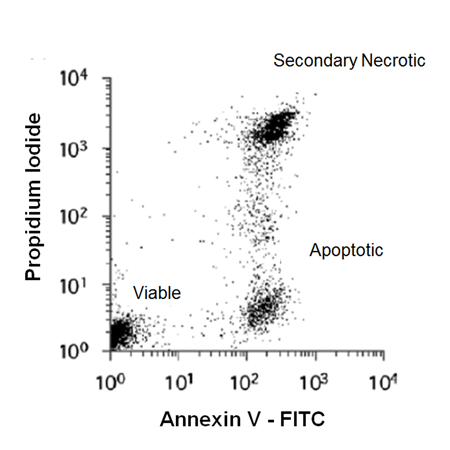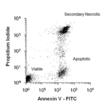Replaces Prod. #: ADI-ADK-700
FITC-labelled recombinant human annexin V shows bright green fluorescence (Ex(max): 488nm, Em(max): 530nm).

Typical flow cytometry results. The Annexin V-FITC apoptosis detection kit allows the detection and discrimination between apoptotic and necrotic cells.
Please mouse over
Product Details
| Applications: | Flow Cytometry, Fluorescence microscopy, Fluorescent detection
|
| |
| Application Notes: | For the detection of apoptotic cells by flow cytometry or microscopy |
| |
| Purity: | ≥98% (SDS-PAGE; HPLC) |
| |
| Handling: | After opening annexin V-FITC, aliquot contents and freeze at -20°C. Avoid freeze/thaw cycles. |
| |
| Shipping: | Blue Ice |
| |
| Long Term Storage: | +4°C |
| |
| Contents: | Annexin V-FITC: 100 tests/500µl; 300 tests/1.5ml;Liquid. In 50mM TRIS, pH 7.4, 100mM sodium chloride, 1% BSA and 0.02% sodium azide.
Binding Buffer: 50ml (4x concentrated)Concentration after dilution: 10mM HEPES/NaOH, pH 7.4, 140mM sodium chloride, 2.5mM CaCl2.
Propidium Iodide: 20µg/ml (100 tests: 1.6ml, 300 tests: 2 x 1.6ml). |
| |
| Protocol: | Flow Cytometry Protocol:
-
Dilute binding buffer 1:4 in distilled water (50ml binding buffer and 150ml water)
-
Brief centrifugation of annexin V-FITC before use is recommended
-
Wash cells in PBS by gentle shaking or pipetting up and down.
-
Resuspend cells in prediluted binding buffer; adjust cell density to 2-5x105/ml
-
Take 195µl cell suspension and add 5µl annexin V-FITC
-
Mix and incubate 10 minutes in the dark at room temperature
-
Wash cells 1x with PBS and resuspend in 190µl prediluted binding buffer
-
Add 10µl of 20µg/ml propidium iodide stock solution (end concentration 1µg/ml)
-
FACS analysis
|
| |
| Regulatory Status: | RUO - Research Use Only |
| |
Product Literature References
Dinuclear doubly bridged phenoxido copper(II) complexes as efficient anticancer agents: S.S. Massoud, et al.; Eur. J. Med. Chem.
246, 114992 (2023),
Abstract;
Stillage Waste from Strawberry Spirit Production as a Source of Bioactive Compounds with Antioxidant and Antiproliferative Potential: C. Spagnuolo, et al.; Antioxidants
12, 421 (2023),
Abstract;
LncRNA XIST sponges microRNA-448 to promote malignant behaviors of colorectal cancer cells via regulating GRHL2: Z. Yan, et al.; Funct. Integr. Genomics
22, 977 (2022),
Abstract;
New glycoconjugation strategies for Ruthenium(II) arene complexes via phosphane ligands and assessment of their antiproliferative activity: D. Iacopini, et al.; Bioorg. Chem.
126, 105901 (2022),
Abstract;
Nigrosporins B, a Potential Anti-Cervical Cancer Agent, Induces Apoptosis and Protective Autophagy in Human Cervical Cancer Ca Ski Cells Mediated by PI3K/AKT/mTOR Signaling Pathway: J. Zhang, et al.; Molecules
27, 2431 (2022),
Abstract;
Mitochondrial dependent pathway is involved in the protective effects of carboxymethylated chitosan on nitric oxide-induced apoptosis in chondrocytes: B. He, et al.; BMC Complement Med. Ther.
20, 23 (2020),
Abstract;
Full Text
Radiotherapy in combination with hyperthermia suppresses lung cancer progression via increased NR4A3 and KLF11 expression: B. Son, et al.; Int. J. Radiat. Biol.
95, 1696 (2019),
Abstract;
Targeting Mitochondrial Oxidative Phosphorylation Abrogated Irinotecan Resistance in NSCLC: S. Lee, et al.; Sci. Rep.
8, 15707 (2018),
Abstract;
Full Text
Radio-protective effect and mechanism of 4-Acetamido-2,2,6,6- tetramethylpiperidin-1-oxyl in HUVEC cells: F. Wang, et al.; Environ. Health Prev. Med.
22, 14 (2017),
Abstract;
Full Text
Effects of the pulsed electromagnetic field PST® on human tendon stem cells: a controlled laboratory study: P. Randelli, et al.; BMC Complement. Altern. Med.
16, 293 (2016),
Application(s): Cell apoptosis analysis, PST and control cells,
Abstract;
Full Text
Nanoparticles of barium induce apoptosis in human phagocytes: L. Mores, et al.; Int. J. Nanomedicine
10, 6021 (2015),
Application(s): Flow cytometry apoptosis assay with human cells,
Abstract;
Full Text
Protective Effects of N-Acetyl-L-Cysteine in Human Oligodendrocyte Progenitor Cells and Restoration of Motor Function in Neonatal Rats with Hypoxic-Ischemic Encephalopathy: D. Park, et al.; Evid. Based Complement. Alternat. Med.
2015, 764251 (2015),
Application(s): Flow Cytometry,
Abstract;
Full Text
GX15-070 (Obatoclax) Induces Apoptosis and Inhibits Cathepsin D- and L–Mediated Autophagosomal Lysis in Antiestrogen-Resistant Breast Cancer Cells : J.L. Schwartz-Roberts, et al.; Mol. Cancer Ther.
12, 448 (2013),
Abstract;
Glucose-Regulated Protein 78 Controls Cross-talk between Apoptosis and Autophagy to Determine Antiestrogen Responsiveness: K. Cook, et al.; Cancer Res.
72, 3337 (2012),
Abstract;
Full Text
Selective FLT3 inhibition of FLT3-ITD+ acute myeloid leukaemia resulting in secondary D835Y mutation: a model for emerging clinical resistance patterns: A. Moore, et al.; Leukemia
26, 1462 (2012),
Abstract;
Full Text
Specific binding of hypochlorite-oxidized HDL to platelet CD36 triggers proinflammatory and procoagulant effects: A. Assinger, et al.; Atherosclerosis
212, 153 (2010),
Abstract;
Related Products














